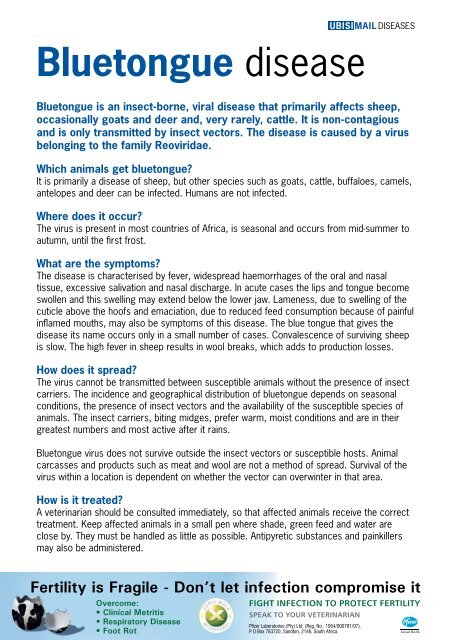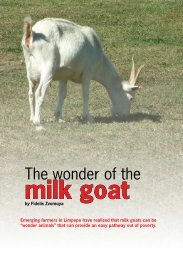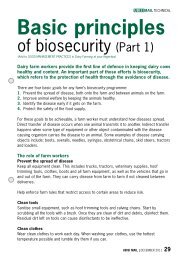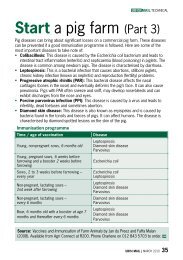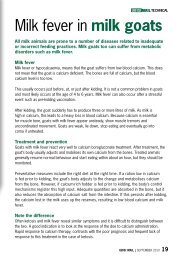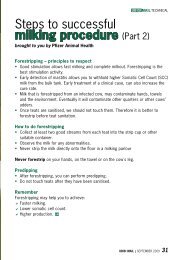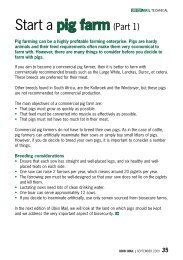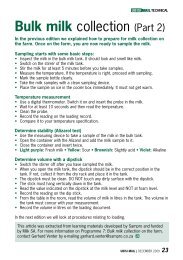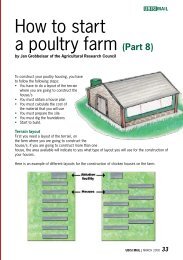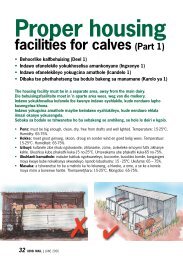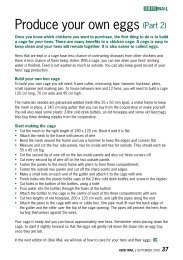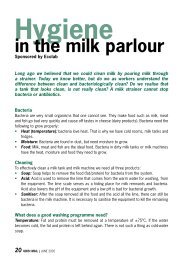Bluetongue disease - Ubisi Mail Magazine
Bluetongue disease - Ubisi Mail Magazine
Bluetongue disease - Ubisi Mail Magazine
Create successful ePaper yourself
Turn your PDF publications into a flip-book with our unique Google optimized e-Paper software.
DISEASES<br />
<strong>Bluetongue</strong> <strong>disease</strong><br />
<strong>Bluetongue</strong> is an insect-borne, viral <strong>disease</strong> that primarily affects sheep,<br />
occasionally goats and deer and, very rarely, cattle. It is non-contagious<br />
and is only transmitted by insect vectors. The <strong>disease</strong> is caused by a virus<br />
belonging to the family Reoviridae.<br />
Which animals get bluetongue<br />
It is primarily a <strong>disease</strong> of sheep, but other species such as goats, cattle, buffaloes, camels,<br />
antelopes and deer can be infected. Humans are not infected.<br />
Where does it occur<br />
The virus is present in most countries of Africa, is seasonal and occurs from mid-summer to<br />
autumn, until the first frost.<br />
What are the symptoms<br />
The <strong>disease</strong> is characterised by fever, widespread haemorrhages of the oral and nasal<br />
tissue, excessive salivation and nasal discharge. In acute cases the lips and tongue become<br />
swollen and this swelling may extend below the lower jaw. Lameness, due to swelling of the<br />
cuticle above the hoofs and emaciation, due to reduced feed consumption because of painful<br />
inflamed mouths, may also be symptoms of this <strong>disease</strong>. The blue tongue that gives the<br />
<strong>disease</strong> its name occurs only in a small number of cases. Convalescence of surviving sheep<br />
is slow. The high fever in sheep results in wool breaks, which adds to production losses.<br />
How does it spread<br />
The virus cannot be transmitted between susceptible animals without the presence of insect<br />
carriers. The incidence and geographical distribution of bluetongue depends on seasonal<br />
conditions, the presence of insect vectors and the availability of the susceptible species of<br />
animals. The insect carriers, biting midges, prefer warm, moist conditions and are in their<br />
greatest numbers and most active after it rains.<br />
<strong>Bluetongue</strong> virus does not survive outside the insect vectors or susceptible hosts. Animal<br />
carcasses and products such as meat and wool are not a method of spread. Survival of the<br />
virus within a location is dependent on whether the vector can overwinter in that area.<br />
How is it treated<br />
A veterinarian should be consulted immediately, so that affected animals receive the correct<br />
treatment. Keep affected animals in a small pen where shade, green feed and water are<br />
close by. They must be handled as little as possible. Antipyretic substances and painkillers<br />
may also be administered.<br />
®<br />
UBISI MAIL | MARCH 2011 35
Sheep <strong>disease</strong>s: <strong>Bluetongue</strong><br />
Symptoms: Fever, listlessness, lacks appetite and breathes rapidly. Swollen eyes, nose<br />
and mouth. The mouth and tongue become blue-red.<br />
Treatment: Consult a veterinarian. Give antibiotics and keep the sheep in the shade.<br />
Prevention: Immunise. Keep sheep in a barn at night.<br />
Bloutong<br />
Simptome: Koors, lusteloosheid, swak<br />
aptyt, vinnige asemhaling.<br />
Opgeswelde oë, neus<br />
en mond. Die mond<br />
en tong kry blou en<br />
rooi vlekke.<br />
Behandeling:<br />
Nader ’n veearts.<br />
Gee antibiotika en<br />
hou die skape in die<br />
koelte.<br />
Voorkoming:<br />
Immuniseer.<br />
Hou die skape snags<br />
in ‘n skuur aan.<br />
36 UBISI MAIL | MARCH 2011
DISEASES<br />
<strong>Bluetongue</strong><br />
Izimpawu zesifo: Imfiva, iyisinambanamba,<br />
ayithandi ukudla futhi iphefumula ngokushesha.<br />
Amehlo, ikhala nomlomo okuvuvukele. Umlomo<br />
nolimi kuba bomvu ngokuluhlaza.<br />
Ukwelashwa: Bonana nodokotela wezilwane.<br />
Nikeza ama-antibhayothiki bese imvu uyigcina<br />
emthunzini.<br />
Ukuvimbela: Goma. Izimvu zigcine<br />
endlini yokuzigcina ebusuku.<br />
Bolwetse bo bitswang <strong>Bluetongue</strong><br />
Matshwao a bolwetse: Feberu, ho fellwa ke matla, ho fellwa ke takatso ya dijo le ho<br />
hema kapele. Ho ruruha ha mahlo, dinku le molomo. Molomo le leleme le ba le mmala o<br />
blou le o mofubedu.<br />
Kalafo: Iteanye le ngaka ya mafu a diphoofolo. Nwesa dinku meriana e lwantshang<br />
mahloko le ho boloka dinku moriting.<br />
Thibelo: Enta dinku. Boloka dinku<br />
lesakeng bosiu.<br />
Isifo solwimi olublowu<br />
(i-<strong>Bluetongue</strong>)<br />
Imiqondiso: Ifiva<br />
(umkhuhlane), ukudangala,<br />
ukungacaceli ukutya<br />
nokuphefumla<br />
ngokukhawuleza. Amehlo,<br />
impumlo nomlomo<br />
odumbuleyo. Umlomo nolwimi<br />
ziba bubublowu obubomvu.<br />
Unyango: Cebisana nogqirha<br />
wezilwanyana. Nika<br />
izibulala-ntsholongwane yaye<br />
ugcine iigusha emthunzini.<br />
Uthintelo: Gonya. Gcina iigusha<br />
ebuhlanti (kwishedi) ebusuku. UM<br />
UBISI MAIL | MARCH 2011 37


